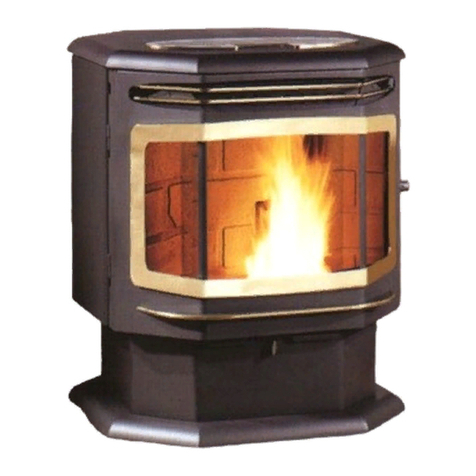• Do not place any objects on the pellet stove or in the area of its direct
radiant heat - fire hazard!
• Do not operate the fireplace over an extended period of time unattended
• When filling the fuel storage tank, ensure that pellets do not fall onto
the convection fins or on hot parts of the cladding - danger of smoke
development!
• Only open the combustion chamber door to clean the combustion cham-
ber and burner plate, and only open the combustion chamber door when
the appliance is switched off and in cold status. Opening the combustion
chamber door during operation triggers an error message and the pellet
stove will be switched off automatically! Close the door again properly
after cleaning.
• If the power cable of this appliance is damaged, it must be replaced by
the customer service organization or a person with similar qualifications
(e.g. qualified electrician) to avoid a hazard.
• The ambient temperature is above about 15°C. The weather conditions
and supply pressure are unfavourable (e.g. fog). These weather condi-
tions occur most frequently in spring and fall. The burnup may therefore
be slightly uneven.
• Your fireplace draws the combustion air from the installation area (open
flue operation). Ensure that there is a sufficient supply of fresh air to
the room in which the stove is installed (for more details, refer to ‚Gen-
erally recognised rules of technology‘ or speak to your local chimney
sweep. The fresh air supply must be checked by the installer and the
operator. When operating several fireplaces in a single room or a linked
space, ensure that sufficient air is available for complete combustion!
It is possible that there is not a sufficient supply of fresh air if the
windows and doors are sealed (e.g., in combination with energy saving
measures). As a result, the ventilation of the tiled stove can be affected.
This can adversely affect your well-being and, potentially, your safety.
If necessary, an air flap must be installed near the pellet stove for the
additional supply of fresh air, or a combustion air line must be routed
outwards or in a well-ventilated room (except for the heating room).
In particular, ensure that the necessary combustion air pipes are open
during the operation of the fireplace insert. Simultaneous operation
with a ventilation system (e.g. extractor hood, bathroom fan, etc.) in the
same room or connected space can adversely affect the function of the
fireplace (to the point of smoke or flue gas accumulating in the living
room, despite the firebox door being closed). It is therefore prohibited to
operate appliances of this kind simultaneously with a fireplace without
first taking appropriate precautionary measures. If any questions arise,
please contact your chimney sweep.
• Your pellet stove is connected to the chimney with Ø 100 mm connecting
pieces made of steel plate which is at least 2 mm thick. These must
comply with the ‚Generally recognized rules of technology‘ and must
therefore be connected properly to the chimney. The connecting piece
must be routed to follow the shortest route between fireplace insert and
chimney. The flue gas path must never point downwards. Instead, it must
wherever possible always be directed upwards towards the chimney.
To achieve this, ensure that the flow of flue gas is redirected as few
times as possible. Ensure that the exhaust pipe is stable/robust; where
appropriate, the exhaust pipe may need to be secured with brackets.
If the flue leads through a combustible wall or is located close to any
combustible components, the flue is to be insulated according to the
respective regulations. In all cases, the connecting line must be installed
in a way that enables it at any time to be cleaned easily and reliably.
This must be ensured through a sufficient number of cleaning openings.
The minimum distance from the connecting piece to any combustible
components can increase the distance from the fireplace to combustible
components, in accordance with manufacturer specifications. The speci-
fied minimum distances to combustible components as stated in these
instructions refer to the fireplace and must be adjusted if necessary.
• The combustion of solid fuels will cause sparks to travel from the
fireplace into the chimney. This may ignite the soot in the chimney.
(this rarely happens if the chimney is cleaned regularly by the chimney
sweep). You can detect a chimney fire by:




























